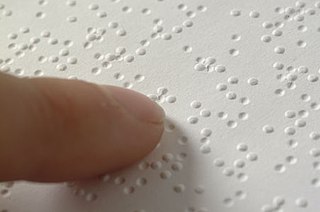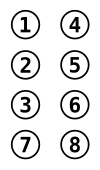
Braille is a tactile writing system used by people who are visually impaired, including people who are blind, deafblind or who have low vision. It can be read either on embossed paper or by using refreshable braille displays that connect to computers and smartphone devices. Braille can be written using a slate and stylus, a braille writer, an electronic braille notetaker or with the use of a computer connected to a braille embosser.

Unicode, formally The Unicode Standard, is an information technology standard for the consistent encoding, representation, and handling of text expressed in most of the world's writing systems. The standard, which is maintained by the Unicode Consortium, defines as of the current version (15.0) 149,186 characters covering 161 modern and historic scripts, as well as symbols, emoji, and non-visual control and formatting codes.

ArmSCII or ARMSCII is a set of obsolete single-byte character encodings for the Armenian alphabet defined by Armenian national standard 166–9. ArmSCII is an acronym for Armenian Standard Code for Information Interchange, similar to ASCII for the American standard. It has been superseded by the Unicode standard.
Mathematical Alphanumeric Symbols is a Unicode block comprising styled forms of Latin and Greek letters and decimal digits that enable mathematicians to denote different notions with different letter styles. The letters in various fonts often have specific, fixed meanings in particular areas of mathematics. By providing uniformity over numerous mathematical articles and books, these conventions help to read mathematical formulas.

Japanese Braille is the braille script of the Japanese language. It is based on the original braille script, though the connection is tenuous. In Japanese it is known as tenji (点字), literally "dot characters". It transcribes Japanese more or less as it would be written in the hiragana or katakana syllabaries, without any provision for writing kanji.
In Unicode, a Private Use Area (PUA) is a range of code points that, by definition, will not be assigned characters by the Unicode Consortium. Three private use areas are defined: one in the Basic Multilingual Plane, and one each in, and nearly covering, planes 15 and 16. The code points in these areas cannot be considered as standardized characters in Unicode itself. They are intentionally left undefined so that third parties may define their own characters without conflicting with Unicode Consortium assignments. Under the Unicode Stability Policy, the Private Use Areas will remain allocated for that purpose in all future Unicode versions.
In computer programming, whitespace is any character or series of characters that represent horizontal or vertical space in typography. When rendered, a whitespace character does not correspond to a visible mark, but typically does occupy an area on a page. For example, the common whitespace symbol U+0020 SPACE represents a blank space punctuation character in text, used as a word divider in Western scripts.

ITC Zapf Dingbats is one of the more common dingbat typefaces. It was designed by the typographer Hermann Zapf in 1978 and licensed by International Typeface Corporation.
Braille ASCII is a subset of the ASCII character set which uses 64 of the printable ASCII characters to represent all possible dot combinations in six-dot braille. It was developed around 1969 and, despite originally being known as North American Braille ASCII, it is now used internationally.
A Unicode font is a computer font that maps glyphs to code points defined in the Unicode Standard. The vast majority of modern computer fonts use Unicode mappings, even those fonts which only include glyphs for a single writing system, or even only support the basic Latin alphabet. Fonts which support a wide range of Unicode scripts and Unicode symbols are sometimes referred to as "pan-Unicode fonts", although as the maximum number of glyphs that can be defined in a TrueType font is restricted to 65,535, it is not possible for a single font to provide individual glyphs for all defined Unicode characters. This article lists some widely used Unicode fonts that support a comparatively large number and broad range of Unicode characters.
In Unicode and the UCS, a compatibility character is a character that is encoded solely to maintain round-trip convertibility with other, often older, standards. As the Unicode Glossary says:
A character that would not have been encoded except for compatibility and round-trip convertibility with other standards
Many scripts in Unicode, such as Arabic, have special orthographic rules that require certain combinations of letterforms to be combined into special ligature forms.
The Universal Coded Character Set is a standard set of characters defined by the international standard ISO/IEC 10646, Information technology — Universal Coded Character Set (UCS), which is the basis of many character encodings, improving as characters from previously unrepresented typing systems are added.
The Unicode Standard assigns various properties to each Unicode character and code point.
Louis Braille's original publication, Procedure for Writing Words, Music, and Plainsong in Dots (1829), credits Barbier's night writing as being the basis for the braille script. It differed in a fundamental way from modern braille: It contained nine decades (series) of characters rather than the modern five, utilizing dashes as well as dots. Braille recognized, however, that the dashes were problematic, being difficult to distinguish from the dots in practice, and those characters were abandoned in the second edition of the book.
Computer Braille is an adaptation of braille for precise representation of computer-related materials such as programs, program lines, computer commands, and filenames. Unlike standard 6-dot braille scripts, but like Gardner–Salinas braille codes, this may employ the extended 8-dot braille patterns. The resulting 256 braille characters are assigned to the 256 characters of 8-bit computer encodings.
Old Italic is a Unicode block containing a unified repertoire of several Old Italic scripts used in various parts of Italy starting about 700 BCE, including the Etruscan alphabet and others that were derived from it. All those languages went extinct by about the 1st century BCE; except Latin, which however evolved its own Latin alphabet that is covered by other Unicode blocks.
The Braille pattern dots-0 , also called a blank Braille pattern, is a 6-dot or 8-dot braille cell with no dots raised. It is represented by the Unicode code point U+2800, and in Braille ASCII with a space.





